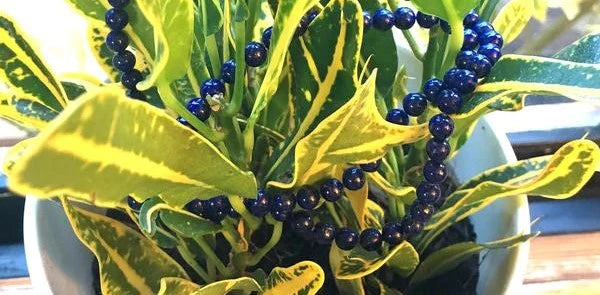Part 2: Plant Rejuvenation
This is the second of a five-part series in which Gemisphere Office Manager Michelle answers your questions about how to energetically cleanse your gemstones. Upcoming posts will feature Water Rinse, Sun Bath, and Clay Cleanse methods. Read Part 1: Salt Bed here.
My favorite way to cleanse gemstones is the Plant Rejuvenation method. Since gems come from the Earth, bringing them into contact with its energy through a living, growing source just feels good and is especially refreshing to the gems. Like the Salt Bed, Plant Rejuvenation is a universal cleansing method, meaning it is safe and effective for all gemstones. It is also just as simple to perform. A happy houseplant or any healthy, shady, and secure tree, shrub, bush, or potted plant will do. And unlike the Salt Bed, you don’t have to change the plant every two weeks!
Here are the questions I hear most often about Plant Rejuvenation:
What is the Plant Rejuvenation method?
In this method, you use the living energy field generated by plants to absorb the disharmonious energies that naturally collect on the surface of therapeutic gems during the course of their work. Regularly clearing away these energies allows the gems to work at their full capacity. You simply place your gemstones in the branches or wrap them around the base of a healthy plant or tree.

Is an indoor or outdoor plant best?
Either will work, but I have found that the addition of fresh air and proximity to the ground make outdoor cleansing a somewhat deeper and more rejuvenating cleanse. If you cleanse your gems outdoors, to prevent loss of your gems, be sure to choose a plant or tree in a secure spot, such as a private yard or balcony. Also, choose a plant or tree that provides the gems with shade, so they are not exposed to direct sunlight.
Why should the gems not be placed in direct sunlight?
Not all gemstones are suited for cleansing in sunlight, and any gemstone can become energetically “sunburned” if it is overexposed to the sun. For extra protection for sun-sensitive gems, cover them with a natural-fiber cloth while they are outdoors. To learn whether your gems are sensitive to the sun, see the information card that came with their packaging or visit the gemstone’s dedicated page on Gemisphere.com.
What kind of plant should I use?
Any vibrant, healthy plant or tree will work. The more lush and vital it is, the better it will be at cleansing gems.
TIP: For prickly reasons, I would avoid cacti.
How long should I leave the gems in the plant?
As with the Salt Bed, at least an hour to overnight.
Where in the plant should I place my gems? Around the base or in the branches?
Either will work, so feel free to place your gems where you feel drawn to place them. If you place them around the base, you can lay a natural-fiber cloth under the gems to keep them from picking up any soil.
Can I place more than one gemstone necklace in the same plant?
Yes! As with the Salt Bed, you will want to make sure the plant is large enough to give each necklace its own space.
How often should I cleanse my gemstones in a plant?
As with the Salt Bed, for most gemstones that you are wearing every day, cleanse them at least two to three times per week. Some gems require more frequent cleansing, so be sure to read the individualized information card that came with your gems for more details. Because therapeutic gemstones work better when they’re cleansed, I find it’s a good habit to cleanse them after each use.

Is it safe to leave my gemstones outside overnight in the winter? Will the cold damage them?
That depends on the gemstone. For example, Citrine loves the cold and is invigorated by it (you can even place your Citrine in snow for an extra treat). More brittle gems, like Apatite and Fluorite, may be damaged by extreme temperature changes, so I would avoid leaving them outside if you feel it is too cold. If you are concerned about temperature, I would simply use a different cleansing method during the colder months.
Is it OK to leave my gemstones outdoors if it is raining or wet outside?
For gemstones that can be safely cleansed with the Water Rinse method, yes—leaving them out in the rain provides a very nice cleanse indeed! For necklaces containing softer gems, I would advise against leaving them out in the rain. Necklaces containing softer gemstones include: Angelfire, Apatite (and all Apatite combinations), Blue Phoenix, Breanna, Brigid, Coral, Fluorite Rainbow, Golden Phoenix, Indigo, Lapis Lazuli, Lavender Light, Lavender Rainbow, Libra, Light Stream, Magic Gift, Malachite, Mother of Pearl, Ocean Rainbow, Patience, Pharaoh, Purple Eagle, Rhodochrosite, Sodalight, Star Aqua, and True Self.
TIP: If the plant is damp from a previous rainfall, or if you want to avoid getting wet dirt on your gemstones, you can place them in a natural-fiber bag or wrap it in a breathable, natural-fiber cloth and place them in the plant. Cheesecloth or a handkerchief works well!
Know Your Gemstones
Not all gemstones are cleansed the same way or with the same frequency, so I encourage you to read the individual care and cleansing instructions found on the information card that came with your gems. You can also find this information at Gemisphere.com in the How to Use tab on each gemstone’s dedicated page.
Detailed instructions on each cleansing method can be found here.
Did you miss last week’s post? Read all about the Salt Bed method here.
Tune in next week for my answers to your questions about the Water Rinse!
Questions? Our Gemstone Advisors are happy to answer them. Call us at 800.727.8877. Happy Cleansing!
Shop All Gemisphere Therapeutic Gemstone Necklaces




